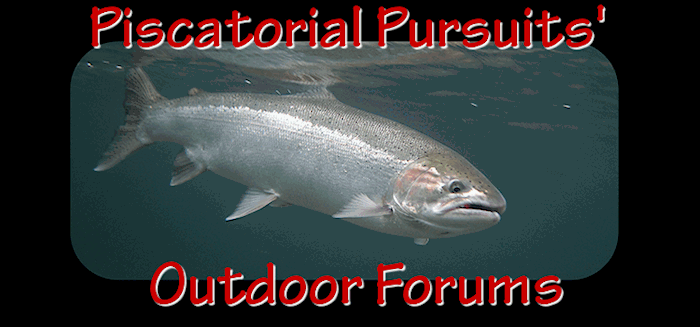Don't be fooled, guys... all nets are really bad, and even when the WDFW & commercials talk about fish mortality, almost all the time they're talking about what the fish look like when they're thrown back in the water... what they really need to do is keep them in captivity and study them for a couple of weeks... many times, netted or man-handled fish develop bacterial infections and die due to scale or protective layer loss... sometimes many days after being released. In salt water, massive scale loss can lead to dehydration. Another point to these "tangle" nets is that they need to be tended regularly to keep the mortality down... this has always been a big problem with commercials, too.
The following is an excerpt from Terry Sheely's article in the April 2001 issue of "The Reel News"... I think he says it well.
TANGLE NET BULL ROAR
WDFW is making some outlandish statements regarding nets and live fish release. It's not what they say it's what they don't say that's troubling.
WDFW's test of industrial tangle nets in Puget Sound and Willapa Bay indicates a slightly higher survival rate for netted fish. According to WDFW 55 percent of chinook and coho caught with a standard gillnet were still healthy enough to swim away from the boat after release.
By comparison. about 82 percent of the chinook and coho salmon released from a tangle net still appeared healthy.
Key words in those two department lines are. "healthy enough to swim away" and
"still appeared healthy."
When sport fishermen were arguing for hook and release fisheries WDFW required caught fish to be held for days in cages to see how many died after apparent healthy releases. And even then. when faced with the negligible mortality of catch-and-release fishing, rather than open more sport fishing opportunities, they denied the evidence and retreated to the comfort of their own old bad science.
The question is why aren't industrial netters held to the same standards, and since when is a "swim away" now considered a "healthy" release. Even 7th grade biology students can shoot holes in those findings. But not WDFW.
Even under the best case scenario that means 18 percent of all netted wild salmon, including ESA listed runs, will be killed by industrial boats and discarded.
18 PER CENT !!!!!!!!
According to WDFW 18 percent industrial mortality is OK.
OK!
This same WDFW just a few years ago found that a 1.5 to 3 percent catch and release mortality was unacceptably high to permit a catch-and-release sport season?
Here's the kicker. About the same time that industrial fishermen were being given attaboys for hooking salmon by the head, wrapping them in net mesh, hauling them onto deck, jerking them free of the mesh and throwing them overboard to "swim away"-- WDFW issued a press release warning sport fishermen not to touch, net, or beach wild salmon. The release from WDFW warns "Sportsmen are urged not to remove salmon with an adipose fin [wild] from the water and to avoid netting the fish. Netting causes the "loss of protective scales"
That deserves repeating. "Netting causes the loss of protective scales."
Hypocritical double-standard aside, shame on you Jeff Koenings. Shame. If you really want to save fish just pull the nets out of the river. The state economy won't even hiccup at the loss.
Or if doing the right thing and banning nets is too tough a pill for you to swallow, then how about requiring industrials to use the new floating box trap. Tested during the tangle and gill net comparisons floating box traps had an amazing 100 percent survival rate for released fish. The floating box trap captures salmon by funneling them into a small webbed chamber. If it had the highest survival rate then why isn't WDFW requiring it. Possibly because it caught the fewest fish.
Anybody suspect that the tangle net test is just a little feel good smoke and one-way mirrors that WDFW will use to justify continuation of the industrial fishery. That's not a question.
















 Previous Topic
Previous Topic Index
Index

